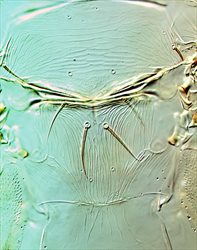
Meso & metanota
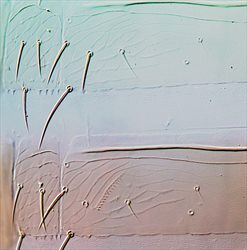
Pleurotergites IV-V
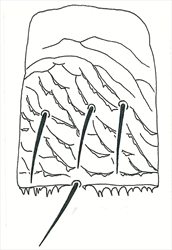
Pleurotergite
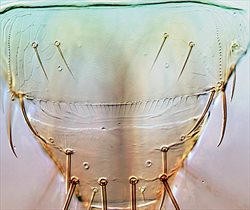
Tergites VIII-IX
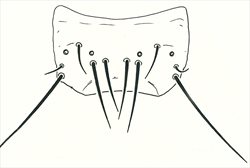
Male tergite IX

Male sternite V
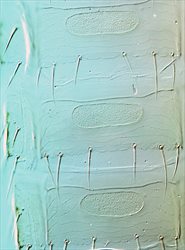
Male sternites IV-VI
Both sexes fully winged. Body and legs yellow, antennal segments IV–V brown distally, VI–VII brown; fore wings pale. Antennae 7-segmented; III–IV each with forked sense cone. Head with 2 pairs of ocellar setae; pair III arising on or just outside anterior margins of ocellar triangle, about as long as distance between two ocelli; postocular setae pairs I & III about as long as ocellar setae III, postocular setae pair II minute. Pronotum with 2 pairs of posteroangular setae; posterior margin with 3 pairs of setae. Mesonotum with paired anterior campaniform sensilla, median setae distant from posterior margin. Metanotum closely striate medially with lines converging posteriorly; median setae arising behind anterior margin; campaniform sensilla present. Fore wing first vein with 3 setae on distal half; second vein with about 12 setae. Abdominal tergite II with 3 lateral marginal setae; tergites V–VIII with paired ctenidia, on VIII posteromesad to spiracles; tergite VIII posteromarginal comb complete with long microtrichia; tergite IX with two pairs of campaniform sensilla, X with median split; pleurotergites with 2–3 discal setae, posterior margins with microtrichia. Sternites without discal setae; VII with setae S1 in front of margin.
Male similar to female but smaller; sternites III–VII with large broadly transverse pore plate.
The genus Thrips is the second largest genus in the Thysanoptera, and currently includes, worldwide, over 290 species. All members of genus Thrips lack ocellar setae I on the head, and they all have ctenidia on tergite VIII posteromesad to the spiracles. Other characters, such as number of antennal segments, number of setae on the fore wing veins, and number of discal setae on the sternites are variable between species (Palmer, 1992; Nakahara, 1994; Mound & Masumoto, 2005). The combination of the presence of pleurotergal discal setae and absence of sternal discal setae is unusual, and Thrips brevicornis is one of only three such species recorded in Britain. The other two are both dark in colour, Thrips fulvipes, and the Japanese Flower Thrips, Thrips setosus, that was first recorded in Britain in 2016.
Reported from the flowers of various plant species (zur Strassen, 2003), but in Britain records were predominantly from Lonicera species [Caprifoliaceae] (Morison, 1968a), though it has recently been taken from various other plant families.
In Britain, locally common on the south coast of England, and in the south west of Wales, but possibly more common north of the Midlands and present as far north as the Orkney Islands (Mound et al., 1976). It has also been recorded from Northern Ireland (Morison, 1968a). Widespread across Europe, but with some country-level gaps in recording. Also recorded from Mongolia (zur Strassen, 2003).
THRIPIDAE - THRIPINAE
Thrips brevicornis Priesner
Thrips brevicornis Priesner, 1920: 59
Morison GD (1968a) Observations and records for some British Thysanoptera. VII Thripidae, Thrips flavus Schrank and Thrips brevicornis Priesner. The Entomologist 101: 205–212.
Mound LA & Masumoto M (2005) The genus Thrips (Thysanoptera, Thripidae) in Australia, New Caledonia and New Zealand. Zootaxa 1020: 1–64.
Mound LA, Morison GD, Pitkin BR & Palmer JM (1976) Thysanoptera. Handbooks for the Identification of British Insects 1 (11): 1–79.
Nakahara S (1994) The genus Thrips Linnaeus (Thysanoptera: Thripidae) of the New World. United States Department of Agriculture. Technical Bulletin 1822: 1–183.
Palmer JM (1992) Thrips (Thysanoptera) from Pakistan to the Pacific: a review. Bulletin of the British Museum (Natural History) Entomology Series 61 (1): 1–76.
zur Strassen R (2003) Die terebranten Thysanopteren Europas und des Mittelmeer-Gebietes. Die Tierwelt Deutschlands 74: 1–271.